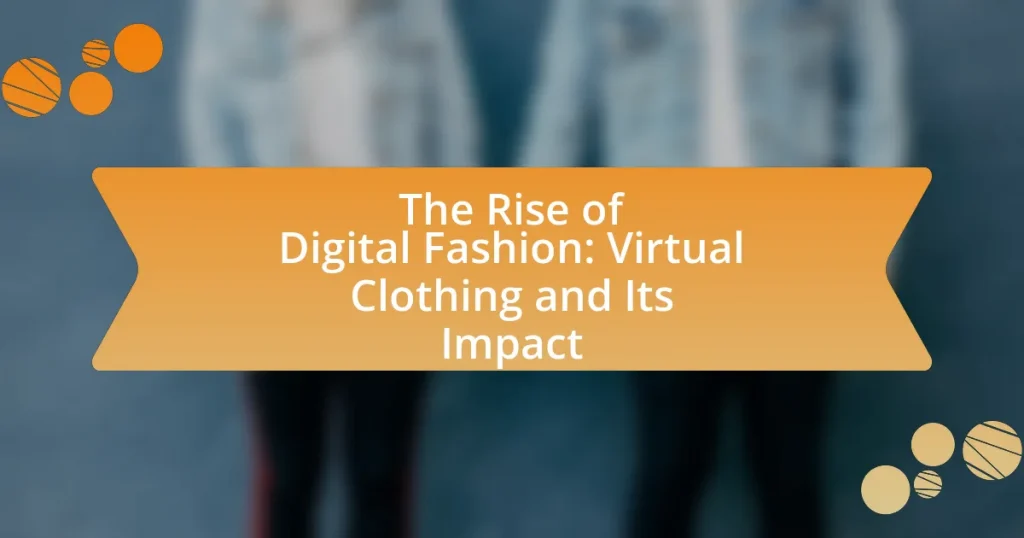Digital fashion, encompassing virtual clothing designed for digital environments, is rapidly transforming the fashion industry. This article explores the evolution of digital fashion, highlighting advancements in technology such as 3D modeling, augmented reality, and blockchain, which have reshaped consumer behavior and sustainability practices. It examines the cultural shifts that have facilitated the acceptance of virtual clothing, the implications for traditional fashion, and the challenges faced by new designers in this emerging market. Additionally, the article discusses the environmental impacts of digital fashion and future trends that will influence its growth and integration into everyday life.

What is Digital Fashion and Virtual Clothing?
Digital fashion refers to clothing that exists in a digital format, often created using 3D modeling and design software, allowing for virtual representation without physical production. Virtual clothing is specifically designed for avatars in digital environments, such as video games, social media platforms, and virtual reality spaces. This form of fashion enables users to express their identity and style in virtual settings, reflecting a growing trend where digital and physical realities converge. The market for digital fashion has expanded significantly, with brands like Balenciaga and Gucci launching virtual collections, indicating a shift in consumer behavior towards digital experiences.
How has digital fashion evolved over the years?
Digital fashion has evolved significantly over the years, transitioning from simple digital representations to complex virtual garments used in various applications. Initially, digital fashion was limited to basic 2D designs and graphics, primarily used in video games and online avatars. As technology advanced, particularly with the rise of 3D modeling software and virtual reality, designers began creating intricate 3D garments that could be worn by digital avatars in virtual environments.
The introduction of augmented reality (AR) and virtual reality (VR) platforms further propelled digital fashion, allowing users to experience clothing in immersive settings. For instance, brands like Balenciaga and Gucci have launched virtual collections that can be worn in digital spaces, showcasing the potential for fashion in the metaverse. Additionally, the rise of social media and influencer culture has facilitated the acceptance and popularity of digital fashion, with platforms like Instagram showcasing virtual outfits.
The market for digital fashion has also expanded, with reports indicating that the global digital fashion industry is projected to reach billions in revenue by the mid-2020s. This growth is driven by increasing consumer interest in sustainability and the desire for unique digital identities. Overall, digital fashion has transformed from a niche concept into a mainstream phenomenon, influencing both the fashion industry and consumer behavior.
What technological advancements have influenced digital fashion?
Technological advancements such as 3D modeling, augmented reality (AR), virtual reality (VR), and blockchain have significantly influenced digital fashion. 3D modeling allows designers to create intricate virtual garments that can be visualized and manipulated in digital environments, enhancing creativity and reducing material waste. Augmented reality and virtual reality technologies enable consumers to try on clothing virtually, providing immersive shopping experiences and increasing engagement. Blockchain technology ensures authenticity and traceability in digital fashion, allowing for secure ownership of virtual items and fostering trust in the marketplace. These advancements collectively reshape how fashion is designed, marketed, and consumed in the digital realm.
How do cultural shifts impact the acceptance of digital clothing?
Cultural shifts significantly enhance the acceptance of digital clothing by altering societal norms and values regarding fashion and technology. As society increasingly embraces digital experiences, such as social media and virtual reality, the perception of clothing evolves from a purely physical item to a digital expression of identity. For instance, the rise of virtual influencers and online fashion shows demonstrates a growing acceptance of digital garments, as evidenced by the 2021 report from McKinsey & Company, which noted that 60% of consumers are open to purchasing digital fashion items. This shift reflects a broader trend where younger generations prioritize sustainability and individuality, further driving the demand for innovative digital clothing solutions.
What are the key characteristics of virtual clothing?
Virtual clothing is characterized by its digital nature, allowing for creation, customization, and interaction within virtual environments. Unlike traditional clothing, virtual garments exist solely in digital formats, enabling users to wear them in online spaces such as video games, social media, and virtual reality platforms. These items can be designed with unique aesthetics, often incorporating animations and interactive elements that enhance user experience. Additionally, virtual clothing promotes sustainability by reducing waste associated with physical garment production, as it eliminates the need for materials and manufacturing processes. The rise of virtual clothing is supported by the increasing popularity of digital avatars and the growing acceptance of virtual identities in social and commercial contexts.
How does virtual clothing differ from traditional fashion?
Virtual clothing differs from traditional fashion primarily in its digital nature, allowing for creation, customization, and consumption without physical materials. Traditional fashion relies on textiles and manufacturing processes, which involve tangible resources and labor, while virtual clothing exists solely in digital environments, enabling users to wear and showcase outfits in virtual spaces or through augmented reality. This shift reduces environmental impact associated with production and waste, as evidenced by the growing trend of brands like Balenciaga and Gucci launching digital-only collections, which cater to a market increasingly interested in sustainability and digital experiences.
What materials and techniques are used in creating digital garments?
Digital garments are created using materials such as 3D modeling software, digital textiles, and rendering engines. Techniques employed include virtual draping, texture mapping, and simulation of fabric physics to replicate the behavior of real-world materials. For instance, software like Clo3D and Marvelous Designer allows designers to create realistic garment simulations by mimicking how fabrics interact with gravity and movement. These tools enable the visualization of intricate details and textures, enhancing the authenticity of digital clothing.

What are the implications of Digital Fashion on the Fashion Industry?
Digital fashion significantly transforms the fashion industry by introducing virtual clothing that reduces waste and enhances consumer engagement. This shift allows brands to create and showcase collections without the environmental impact of physical production, as evidenced by the rise of companies like The Fabricant, which specializes in digital-only garments. Additionally, digital fashion enables immersive experiences through augmented reality and virtual reality, fostering deeper connections between consumers and brands. The global digital fashion market is projected to reach $1 billion by 2025, highlighting its growing importance and influence within the industry.
How is digital fashion reshaping consumer behavior?
Digital fashion is reshaping consumer behavior by enabling virtual try-ons and personalized shopping experiences, which enhance engagement and reduce return rates. Consumers increasingly prefer digital platforms for fashion purchases, as evidenced by a 2022 report from McKinsey, which found that 60% of consumers are open to purchasing virtual clothing. This shift is driven by the convenience of online shopping and the growing acceptance of digital identities in social media and gaming environments. As a result, brands are adapting their marketing strategies to incorporate augmented reality and virtual reality technologies, further influencing consumer preferences and purchasing decisions.
What role do social media and influencers play in promoting digital fashion?
Social media and influencers are pivotal in promoting digital fashion by providing platforms for visibility and engagement. They leverage their large followings to showcase virtual clothing, creating trends and driving consumer interest. For instance, platforms like Instagram and TikTok enable influencers to share styled looks featuring digital garments, which can lead to increased sales and brand awareness. According to a report by McKinsey, 70% of consumers are influenced by social media when making fashion purchases, highlighting the significant impact of these channels on consumer behavior in the digital fashion space.
How does virtual clothing affect purchasing decisions?
Virtual clothing significantly influences purchasing decisions by enhancing consumer engagement and reducing return rates. Studies indicate that virtual try-on technologies allow customers to visualize how clothing fits and looks on them, leading to more informed choices. For instance, a report by the National Retail Federation found that 70% of consumers are more likely to purchase clothing if they can virtually try it on. This technology not only boosts confidence in buying decisions but also minimizes the likelihood of returns, which can be as high as 30% in online apparel shopping. Thus, virtual clothing serves as a critical tool in shaping positive purchasing behaviors.
What are the environmental impacts of digital fashion?
Digital fashion significantly reduces environmental impacts compared to traditional fashion by minimizing resource consumption and waste generation. Traditional fashion relies heavily on physical materials, such as cotton and polyester, which require extensive water, land, and energy resources for production. In contrast, digital fashion eliminates the need for these physical materials, thereby reducing water usage by approximately 2,700 liters per cotton t-shirt and lowering carbon emissions associated with manufacturing and transportation. Furthermore, digital fashion mitigates textile waste, as it allows for virtual clothing that does not contribute to landfill overflow, where over 92 million tons of textile waste are generated annually. By leveraging technology, digital fashion promotes sustainability through reduced environmental footprints and encourages a shift towards more eco-friendly consumption practices.
How does digital fashion contribute to sustainability in the industry?
Digital fashion contributes to sustainability in the industry by reducing waste and resource consumption associated with traditional clothing production. Virtual clothing eliminates the need for physical materials, thereby decreasing the environmental impact of textile manufacturing, which is responsible for significant water usage and pollution. For instance, the fashion industry accounts for about 10% of global carbon emissions, and by utilizing digital designs, brands can minimize their carbon footprint. Additionally, digital fashion allows for virtual try-ons, reducing the need for returns and the associated waste from unsold inventory. This shift towards digital solutions supports a more sustainable model by promoting efficient resource use and lowering the overall environmental impact of fashion.
What are the potential downsides of virtual clothing on the environment?
The potential downsides of virtual clothing on the environment include significant energy consumption and electronic waste generation. The creation and distribution of virtual clothing often rely on high-performance computing and data centers, which consume large amounts of electricity, contributing to carbon emissions. For instance, a study by the International Energy Agency indicates that data centers accounted for about 1% of global electricity demand in 2020. Additionally, the rapid evolution of digital fashion can lead to increased electronic waste as outdated software and hardware are discarded, further straining environmental resources.

What are the Future Trends in Digital Fashion?
Future trends in digital fashion include the rise of virtual clothing, increased integration of augmented reality (AR) and virtual reality (VR), and the growing importance of sustainability. Virtual clothing allows users to wear digital outfits in online environments, enhancing personal expression and reducing waste associated with physical garment production. AR and VR technologies are expected to create immersive shopping experiences, enabling consumers to try on clothes virtually before purchasing. Additionally, brands are increasingly focusing on sustainable practices, utilizing digital fashion to minimize environmental impact by reducing the need for physical inventory and promoting digital-only collections. These trends are supported by the increasing consumer interest in digital identities and the expansion of the metaverse, where digital fashion plays a crucial role in self-representation.
How will advancements in technology shape the future of virtual clothing?
Advancements in technology will significantly shape the future of virtual clothing by enhancing realism, interactivity, and accessibility. Technologies such as augmented reality (AR) and virtual reality (VR) will allow users to experience clothing in immersive environments, enabling virtual try-ons that mimic real-life fitting experiences. For instance, companies like Zeekit and AR Door have developed platforms that utilize AR to let consumers visualize how garments will look on them before purchase. Additionally, artificial intelligence (AI) will facilitate personalized fashion recommendations and design processes, streamlining the creation of virtual clothing tailored to individual preferences. The integration of blockchain technology will also ensure authenticity and ownership of digital garments, as seen in platforms like Decentraland, which uses blockchain to verify ownership of virtual assets. These technological advancements will collectively transform virtual clothing into a more engaging, personalized, and secure experience for consumers.
What role will augmented reality play in digital fashion experiences?
Augmented reality (AR) will play a transformative role in digital fashion experiences by enabling immersive and interactive engagement with virtual clothing. AR technology allows users to visualize and try on digital garments in real-time through their devices, enhancing the shopping experience by providing a realistic representation of how clothing fits and looks on them. For instance, brands like Gucci and Nike have implemented AR features in their apps, allowing customers to see how products appear on their bodies before making a purchase, which can lead to increased customer satisfaction and reduced return rates. This integration of AR in digital fashion not only personalizes the shopping experience but also bridges the gap between physical and virtual retail environments, making it a crucial component of the evolving landscape of fashion commerce.
How might artificial intelligence influence design and customization in digital fashion?
Artificial intelligence significantly influences design and customization in digital fashion by enabling personalized experiences and automating design processes. AI algorithms analyze consumer preferences and trends, allowing designers to create tailored clothing that meets individual tastes. For instance, AI-driven platforms like Stitch Fix utilize machine learning to recommend styles based on user data, enhancing customer satisfaction. Additionally, AI tools can generate unique designs rapidly, as seen with companies like The Fabricant, which leverage AI to create virtual garments efficiently. This integration of AI not only streamlines production but also fosters innovation in digital fashion, making it more accessible and diverse.
What challenges does the digital fashion industry face?
The digital fashion industry faces several significant challenges, including issues related to sustainability, intellectual property rights, and technological limitations. Sustainability concerns arise from the environmental impact of digital fashion production and the energy consumption associated with blockchain technologies used for digital ownership. Intellectual property rights pose a challenge as the ease of copying and distributing digital designs can lead to copyright infringements, complicating the protection of designers’ work. Additionally, technological limitations, such as the need for advanced software and hardware for creating and experiencing digital fashion, can hinder widespread adoption and accessibility. These challenges must be addressed for the digital fashion industry to thrive and evolve effectively.
How do copyright and ownership issues affect virtual clothing?
Copyright and ownership issues significantly impact virtual clothing by determining the legal rights of creators and users in the digital fashion space. These issues arise from the need to protect the intellectual property of designers, as unauthorized use or reproduction of virtual clothing can lead to financial losses and diminished brand value. For instance, in 2021, the case of “Rihanna vs. Fashion Nova” highlighted how copyright infringement in digital fashion can lead to legal disputes, emphasizing the necessity for clear ownership rights. Furthermore, the rise of NFTs (non-fungible tokens) has introduced new dimensions to ownership, allowing designers to sell unique digital garments while ensuring their rights are protected. This evolving landscape necessitates ongoing legal adaptations to address the complexities of digital ownership and copyright in virtual clothing.
What are the barriers to entry for new designers in the digital fashion space?
New designers in the digital fashion space face several barriers to entry, including high technical skill requirements, limited access to advanced software, and a saturated market. The necessity for proficiency in 3D modeling and design software, such as Clo3D or Blender, creates a steep learning curve for newcomers. Additionally, many of these tools can be expensive or require significant investment in hardware, which can deter aspiring designers. The digital fashion market is also becoming increasingly competitive, with established brands and designers dominating visibility and consumer attention, making it challenging for new entrants to gain traction. According to a report by McKinsey & Company, the digital fashion industry is projected to grow significantly, but the competition will intensify, further complicating entry for new designers.
What practical tips can consumers consider when engaging with digital fashion?
Consumers engaging with digital fashion should prioritize understanding the technology and platforms involved. Familiarizing oneself with augmented reality (AR) and virtual reality (VR) applications enhances the experience, as these technologies allow for immersive interactions with digital clothing. Additionally, consumers should consider the sustainability aspect of digital fashion, as many virtual garments reduce waste compared to traditional fashion. Research indicates that the digital fashion industry can significantly lower carbon footprints, with some estimates suggesting a reduction of up to 90% in emissions compared to physical clothing production. Lastly, consumers should explore various digital fashion marketplaces to find unique pieces, as these platforms often feature collaborations with designers and brands that push the boundaries of creativity in fashion.



